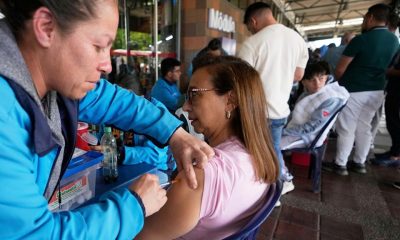International
The Supreme Court of Israel rules on the end of the military exemption for ultra-Orthodox Jews

The Israeli Supreme Court unanimously ruled on Tuesday the end of the military exemption for young ultra-Orthodox Jews, a very controversial measure that has historically divided Israeli society, especially since the war in the Gaza Strip.
The Court decided that “there is no legal basis to exclude ultra-Orthodox men from recruitment” and that if they do not serve in the Army they should not receive educational and social assistance subsidies financed with public funds.
It is not clear whether this ruling implies the immediate sending of recruitment orders for the approximately 67,000 eligible Hareddi men – the equivalent of five military divisions – for compulsory military service at this time, or it will be a gradual process.
The two ultra-Orthodox parties – Shas and United Torah Judaism (JUT) – are frontally opposed to the recruitment of young Torah scholars and have threatened to leave Benjamin Netanyahu’s current government coalition if the measure enters into force, endangering the stability of the Executive, since they provide 18 vital seats.
“There has never been a ruling of the Supreme Court in favor of the students of the yeshivah and in the interest of the ultra-orthodox public. There is not a single judge there who understands the value of the study of the Torah and its contribution to the people of Israel,” said today one of the leaders of JUT, Rabbi and deputy Moshe Gafni.
The military exemption for ultra-Orthodox Jews is not a law, but an executive provision that is prolonged periodically and that exists since the birth of the State of Israel, although there are several judicial judgments that indicate that it violates the principle of equality that governs the Israeli basic law.
The Israeli Supreme Court began at the beginning of June to hear arguments in the case of the military exemption of ultra-Orthodox Jews, who since the formation of the State of Israel can avoid compulsory military service if they study full-time in a Talmudic school (yeshivah).
This issue has caused great divisions in Israeli society and within the government.
At the beginning of April, a temporary rule that allowed the exemption to be maintained expired, and numerous civil society groups have claimed to end the privileges of the ultra-Orthodox, which represent about 13% of the Israeli population.
The Government has been represented in this litigation by a private lawyer, since the Attorney General, Gali Baharav-Miara, has declared herself against the military exemption, going so far as to declare that the Executive acts “without authority” when trying to prevent recruitment.
After the massive mobilization of about 300,000 reservists for the war in Gaza, which has already lasted almost nine months, in addition to for battalions of soldiers both on the northern border with Lebanon and in the occupied territory of the West Bank, many Israelis demand that Netanyahu, that all young people in Israel fulfill their military “duty”.
“There is a real national need to extend the time of service of the soldiers of the permanent army and to extend the period of service of the reservists. Therefore, we are obliged to reach new agreements and make decisions that we had not made in 75 years,” said the Minister of Defense, Yoav Gallant, on this issue.
Central America
Senator Van Hollen Meets with Deported MS-13 Member in El Salvador; Trump and Bukele React

U.S. Democratic Senator Chris Van Hollen, representing the state of Maryland, held a meeting in El Salvador with deported MS-13 gang member Kilmar Ábrego García, a member of the criminal group classified by the U.S. government as a terrorist organization.
“Kilmar Ábrego García, miraculously resurrected from the ‘extermination camps’ and ‘torture chambers,’ now sipping margaritas with Senator Van Hollen in the tropical paradise of El Salvador!” wrote President Nayib Bukeleon X (formerly Twitter), sharing photos of Van Hollen, Ábrego García, and a lawyer sitting together at a Salvadoran hotel.
The deported gang member is seen wearing a plaid shirt and a flat-brimmed cap, seated at a table with glasses and coffee cups. The senator also shared images of the meeting on his own social media accounts.
Bukele reaffirmed that Ábrego will remain in El Salvador and will not be returned to the United States.
“Now that his health has been confirmed, he has earned the honor of remaining under the custody of El Salvador,” Bukele added.
Former U.S. President Donald Trump criticized the senator’s meeting with Ábrego on Truth Social, calling Van Hollen “a fool” for advocating for Ábrego’s return to the U.S.
International
Pope Francis Appears for Easter Blessing, Calls for Peace and Religious Freedom

Pope Francis, still recovering from pneumonia, appeared on the balcony of St. Peter’s Basilica in the Vatican on Easter Sunday and, with a faint voice, wished a “Happy Easter” to the thousands of faithful gathered to celebrate the Resurrection of Christ.
A month after being discharged from a lengthy hospital stay, the presence of the 88-year-old pontiff had remained uncertain, with the Vatican not confirming his attendance ahead of time.
Eventually, the pope made a brief appearance in a wheelchair shortly after 12:00 p.m. (10:00 GMT) to deliver his traditional “Urbi et Orbi” blessing (“to the city and to the world”).
Although no longer wearing an oxygen cannula, the Argentine Jesuit relied on a close aide to read his Easter message, which touched on major global conflicts.
Francis condemned the “dramatic and unworthy humanitarian crisis” in Gaza and called for a ceasefire, while also expressing concern over the “growing climate of antisemitism spreading across the globe.”
He further emphasized the importance of religious freedom and freedom of thought, stating that without mutual respect, “peace is not possible.”
International
Thousands rally nationwide against Trump’s threat to U.S. democracy

Thousands of protesters gathered on Saturday (April 19, 2025) in major cities like New York and Washington, as well as in small communities across the United States, in a second wave of demonstrations against President Donald Trump. The crowds denounced what they view as growing threats to the country’s democratic ideals.
In New York City, demonstrators of all ages rallied in front of the Public Library near Trump Tower, holding signs accusing the president of undermining democratic institutions and judicial independence.
Many protesters also criticized Trump’s hardline immigration policies, including mass deportations and raids targeting undocumented migrants.
“Democracy is in grave danger,” said Kathy Valyi, 73, the daughter of Holocaust survivors. She told AFP that the stories her parents shared about Adolf Hitler’s rise to power in 1930s Germany “are happening here now.”
In Washington, demonstrators voiced concern over what they see as Trump’s disregard for long-standing constitutional norms, such as the right to due process.
-

 International4 days ago
International4 days agoArsenal stun Real Madrid at the Bernabéu to reach Champions League semifinals
-

 Central America3 days ago
Central America3 days agoNicaraguan Exiles to Mark 7th Anniversary of 2018 Protests with Global Commemorations
-

 International3 days ago
International3 days agoDominican ‘False Hero’ Arrested for Faking Role in Nightclub Collapse That Killed 231
-

 International2 days ago
International2 days agoACLU seeks emergency court order to stop venezuelan deportations under Wartime Law
-

 International4 days ago
International4 days agoBogotá residents line up for yellow fever vaccine amid national alert
-

 International4 days ago
International4 days agoDeSantis’ immigration crackdown sparks alarm in Venezuelan Communities in Doral
-

 Central America2 days ago
Central America2 days agoUN complaint filed against Costa Rica over detention of migrant children
-

 International4 days ago
International4 days agoMexico refuses to restore ties with Ecuador while Noboa remains in office
-

 International1 day ago
International1 day agoThousands rally nationwide against Trump’s threat to U.S. democracy
-

 Central America9 hours ago
Central America9 hours agoSenator Van Hollen Meets with Deported MS-13 Member in El Salvador; Trump and Bukele React
-

 International9 hours ago
International9 hours agoPope Francis Appears for Easter Blessing, Calls for Peace and Religious Freedom















